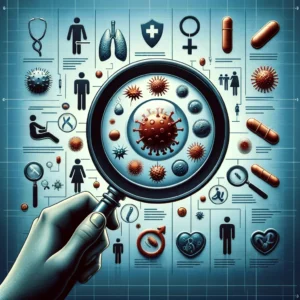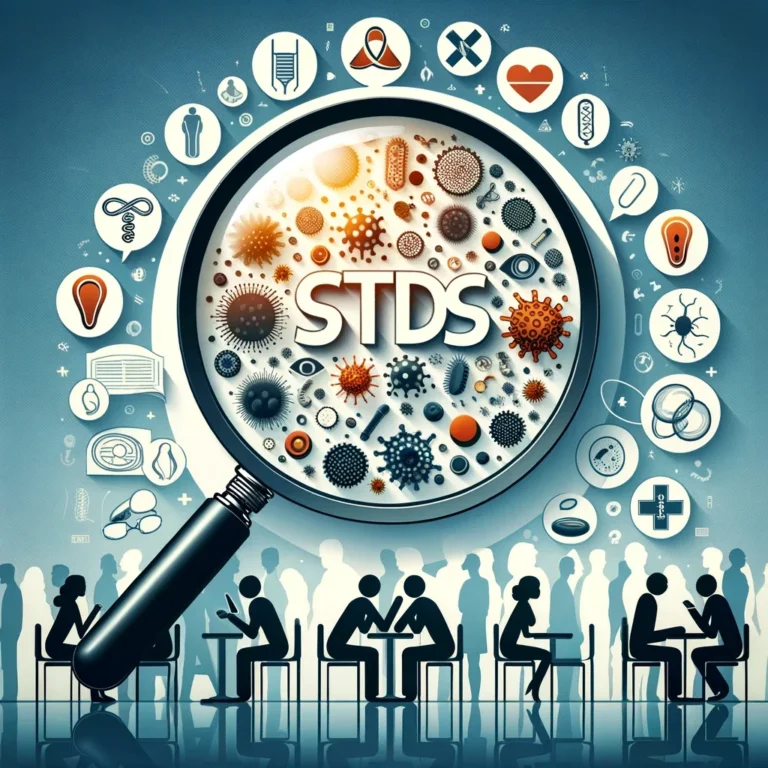What if you could avoid a potentially life-threatening condition with a simple test? That’s the power of STD screening, one of the most effective ways to protect yourself and your partner from sexually transmitted diseases.
STDs are common, but often silent, infections that can have serious consequences if left untreated.
In this article, you will learn everything you need to know about STDs—how they are transmitted, what signs to look out for, and how to prevent them. By the end of this article, you will be well informed and empowered to take charge of your sexual health.
What are Sexually Transmitted Diseases and How are They Spread?
Sexually transmitted diseases, as the name suggests, are infections passed from one person to another primarily through sexual contact. According to the CDC, there are over 30 different viruses, bacteria, and parasites categorized as STDs. These include:
- Bacterial STDs like chlamydia, gonorrhea, and syphilis
- Viral STDs like HIV, genital herpes, human papillomavirus (HPV)
- Parasitic STDs like trichomoniasis
You can contract an STD through vaginal, anal, or oral sex with someone who has the infection. Specific high-risk activities include:
- Having unprotected sex without a condom
- Having multiple sexual partners
- Sharing sex toys without proper sterilization between uses
- Having a sexual encounter under the influence of alcohol or drugs increases risky behavior
Pregnant women can also pass certain STDs like syphilis, HIV, or hepatitis B virus to their baby during pregnancy or delivery. STDs spread through blood like HIV and hepatitis B/C can also be transmitted via shared needles, accidental needle pricks, or transfusions.
Recognizing the Signs and Symptoms
![]()
Many STDs do not produce any noticeable symptoms, especially in the early stages after contracting the infection. You could be infected and easily spread the disease to others without knowing it.
However, some common red flags include:
- Unusual discharge, sores, or bumps around the genitals or mouth
- Pain or burning during urination and intercourse
- Itching, swelling, and irritation around the genital region
- Rashes or skin lesions especially around the mouth, hands, or feet
- Pain in the abdominal or pelvic region
The specific symptoms vary based on the type of STD:
Chlamydia: Often asymptomatic but can cause abnormal vaginal discharge, bleeding between periods, and burning urination when symptoms occur.
Gonorrhea: Many cases show no symptoms. When present, pain or burning urination, pus-like yellow discharge from the penis or vagina, and swollen testicles can occur.
HPV: Can manifest as cauliflower-like genital warts around the vulva, vagina, cervix, penis, scrotum or anus. Instances with no visible warts are also possible.
Herpes: Characteristic painful blisters or sores around the genital area are the most common symptom. Some experience flu-like symptoms like swollen lymph nodes and fever before the rash develops.
HIV: Flu-like symptoms, fever, sore throat, and swollen lymph nodes within 2-4 weeks of infection. Late-stage HIV progresses to opportunistic infections and AIDS without treatment.
Syphilis: Begins with painless genital sores, followed by a non-itchy body rash, and finally in the late stage can cause damage to the heart, brain, and other organs if left untreated.
Do not dismiss these seemingly mild symptoms assuming it to be something trivial like a yeast infection or urethritis. Book an appointment with your doctor or visit a sexual health clinic to get tested if you notice any of these signs after a high-risk sexual encounter. Timely diagnosis and treatment are crucial.
Why are STD Testing and Screening Important?

Getting tested is vital even if you do not have any visible symptoms of an STD. Here’s why early detection through regular screening matters:
- Prevents further transmission: You cannot spread what you do not have. Testing lets you know your status so you can take precautions and not pass infections to future partners.
- Allows early treatment: Identifying STDs early on makes treatment easier before complications set in. For diseases like HIV, starting antiretroviral therapy immediately helps suppress viral load leading to better health outcomes.
- Reduces risk of long-term health issues: Untreated STDs like gonorrhea and chlamydia can lead to pelvic inflammatory disease, infertility, and chronic pain. Undiagnosed HIV and syphilis present a risk of organ damage and even death.
- Peace of mind: Testing negative gives you a clean slate to engage in sexual activity more confidently. Getting treated promptly allows you to eliminate worrying about these diseases.
- Routine prenatal and newborn screening: Getting tested during pregnancy prevents passing infections like syphilis, and hepatitis B/C onto the baby. Newborn screening is also recommended to enable prompt treatment for certain STDs.
The CDC recommends all sexually active individuals between ages 13 to 64 be screened for HIV at least once as part of routine health care. Those at high risk should retest annually. Sexually active gay, bisexual, and transgender individuals can start testing every 3 to 6 months. Ask your doctor which STD screening schedule is suitable for your sexual history and level of risk.
Understanding STD Diagnostic Tests and Procedures
If you suspect you may have contracted an STD after observing symptoms or engaging in unprotected sex, visit your primary care physician, gynecologist, urologist or a sexual health clinic to get tested. Based on your sexual history, the doctor will determine which of the following diagnostic tests are appropriate:
Blood Tests: Drawing a blood sample lets doctors check for STDs that spread through the bloodstream like HIV, syphilis, and hepatitis B/C. This method offers accurate results.
Urine Sample Analysis: Simple urine tests can detect chlamydia and gonorrhea infections. You may be asked to provide the first urine sample of the day.
Gram Stain: Secretions from sores are smeared onto a glass slide and stained to examine any bacteria under a microscope. This helps diagnose gonorrhea.
DNA Probe Test: This directly detects the genetic material of specific pathogens like HPV and chlamydia in your urine or genital discharge sample.
PCR Test: Also examining genetic markers, this test offers a very sensitive way to diagnose GC, chlamydia, HIV, genital herpes, trichomoniasis, and other STDs from urine, blood, or swab samples.
Pap Smear: Primarily screens for cervical cancer, the Pap test also inspects cervical cells for abnormalities or precancerous changes due to HPV infection.
Herpes Sample Culture: Your doctor may take a swab sample from the sore, lesion, or blister to try and culture the Herpes Simplex Virus in laboratory conditions for positive identification.
Rectal and Pharyngeal Swabs: These samples from the throat and anus can diagnose gonorrhea and chlamydia infections in those engaging in oral and anal sex.
If you test positive, cooperate with your doctor’s instructions for medication adherence, partner notification, and follow-up testing to confirm the cure. Your sexual health depends on it.
Evidence-Based Prevention Strategies
Taking some common-sense precautions can go a long way in protecting your sexual wellbeing:
- Use condoms correctly every time: Proper use of latex and polyurethane condoms acts as a strong barrier against STD pathogens. Condoms also protect from unplanned pregnancy.
- Limit sexual partners: Having multiple or concurrent sexual partners raises your STD exposure risk. Being monogamous with a partner who has tested negative is safer.
- Get vaccinated: Vaccines that build immunity against hepatitis A/B virus and HPV strains that cause genital warts and cervical cancer are available.
- Never share needles or tattoo equipment: Injection drug users are extremely vulnerable to diseases like HIV and hepatitis C. Avoid needle sharing and reuse.
- Ask about your partner’s status: Have an open discussion with your partner about their sexual history and ask them to get tested before engaging in unprotected sex. Honesty about any past infections allows informed decision-making.
- Avoid excessive alcohol/drugs during sex: Being under the influence impairs judgment leading to more high-risk behaviors like not using protection, multiple partners, lowered inhibitions, etc.
Empower yourself with knowledge about STDs, get screened regularly, and make healthy choices. Be proactive about your sexual health. With some care and precaution, you can enjoy intimacy while keeping STDs at bay.
Finding Support For STD Prevention and Treatment
Living with an STD or even the possibility of infection can induce fear, anxiety, and emotional distress. But remember you are not alone. Numerous public health facilities and online communities exist to provide STD-related information, testing services, counseling, and treatment support discreetly. You can find help through:
- Your personal physician, gynecologist, urologist – ask for STD screening.
- Local public health department clinics – offer free or low-cost testing.
- Family planning clinics like Planned Parenthood.
- Community health centers and STI clinics provide testing, treatment, and counseling.
- Online support groups and forums to exchange experiences and advice anonymously.
- National hotlines like CDC’s STD & HIV/AIDS hotline offer access to trained health professionals.
- Apps like GYT: Get Yourself Tested allow you to find nearby testing locations.
Do not let stigma or embarrassment prevent you from seeking diagnosis and treatment for possible STDs. Visit a clinic, call a hotline, or have an open discussion with your doctor – they are there to help, not judge. With correct information and supportive care, you can safeguard not just your own sexual health but that of your partner and community.
Conclusion: Stay Vigilant, Get Tested and Make Healthy Choices
STDs remain highly prevalent but are also largely preventable through responsible sexual behaviors. Be aware of your own risk factors based on sexual history and get screened regularly, even if asymptomatic. Diagnose STDs at the first signs and cooperate fully with treatment. Make informed choices about protection and partners.
No one is immune to STDs. But with the right knowledge, prevention skills, and an open, proactive attitude towards sexual health, protecting yourself is possible. Stay vigilant, get tested, and make healthy intimate choices. Your sexual well-being lies in your hands.

